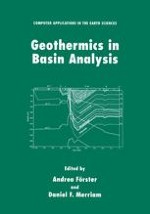1999 | OriginalPaper | Buchkapitel
Thermal Insulation by Low Thermal Conductivity Shales: Implications for Basin-Scale Fluid Flow and Heat Transport
verfasst von : Jeffrey A. Nunn, Guichang Lin, Libo Zhang
Erschienen in: Geothermics in Basin Analysis
Verlag: Springer US
Enthalten in: Professional Book Archive
Aktivieren Sie unsere intelligente Suche, um passende Fachinhalte oder Patente zu finden.
Wählen Sie Textabschnitte aus um mit Künstlicher Intelligenz passenden Patente zu finden. powered by
Markieren Sie Textabschnitte, um KI-gestützt weitere passende Inhalte zu finden. powered by
Organic-rich, fine-grained sediments, such as shale and mudstone, are deposited in many sedimentary basins. These sediments are characterized by thermal conductivities in the range of 0.8 to 1.45 W/m°C, lower by a factor of 2 than other abundant sedimentary rocks. Thus, they act as a thermal blanket retaining heat energy within the sedimentary basin. A two- dimensional finite-element model of fluid flow and heat transport has been used to study the insulating effect of low thermal conductivity shales on an uplifted foreland basin. Our model section cuts through the Arkoma Basin to Ozark Dome and terminates near the Missouri River, west of St. Louis. Topographically driven recharge is assumed to be the major driving force for regional groundwater flow. Our model results show that the thermal gradient in the top layer can be up to 0.08°C/m, higher than normal geothermal gradients of 0.02–0.04°C/m. High temperatures in the discharge region of the basin are caused by thermal insulation and high rates of advective heat transport associated with basin-scale fluid flow along basal aquifers (Darcy velocities greater than 6 m/yr.). Our model results show high temperatures (≈90°C) in the groundwater discharge region at shallow depths (<1 km), even with a typical continental basal heat flow of 60 mW/m2. A modest 34% decrease in thermal conductivity of the top layer of sediment (2.0 to 1.33 W/m°C) elevates temperatures in underlying basin sediments by 15–20°C for millions of years. This change in temperature history is roughly equivalent to the thermal effect of fluid flow by topographic recharge for the model basin considered here. Initial steady-state conduction temperatures range from 45 °C to 7.5 °C higher depending on the thickness of the insulating shale layer. Elevated temperatures will persist for as long as the low thermal conductivity shales cover the basin.
